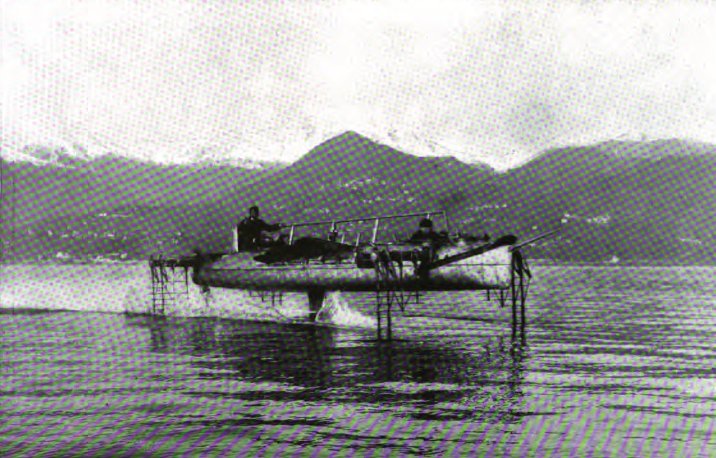<Back to Index>
- Aeronautical Engineer Alphonse Pénaud, 1850
- Archaeologist Gustave de Ponton d'Amécourt, 1825
- Aeronautical Engineer Enrico Forlanini, 1848
PAGE SPONSOR
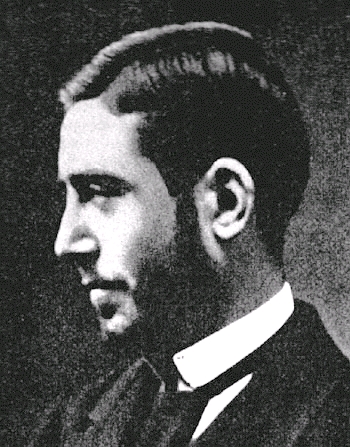
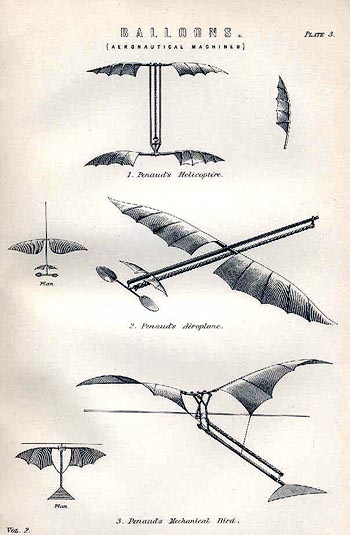
Alphonse Pénaud (May 31, 1850 – October 22, 1880), was a 19th century French pioneer of aviation design and engineering. He was the originator of the use of twisted rubber to power model aircraft, and his 1871 model airplane, which he called the Planophore, was the first truly successful automatically stable flying model. He went on to design a full sized aircraft with many advanced features, but was unable to get any support for the project, and eventually committed suicide in 1880, aged 30.
Pénaud was born in Paris into a naval family, his father being an admiral in the French Navy. Because of a hip disease he walked with the aid of crutches and so was unable to attend the Naval School. At 20, he began studying aviation and joined the newly founded Société Aéronautique de France. He became vice president of the Society in 1876 and participated in the publication of the journal L'Aéronaute.
In 1870 Pénaud made the first of a series of successful model
helicopters. The principal of this was not new, having been demonstrated
to French Academy of Sciences in 1784 by M. Launoy, a naturalist, and
M. Bienvenu., and was known by Sir George Cayley,
but it was the first used of twisted rubber to power a flying model.
During the early years of the development of heavier - than - air flight
many experimenters were to use this method of propulsion for
experimental models, including Lawrence Hargrave and A.V. Roe.
The next year he built the Planophore, which was to be a major influence on early aircraft design. In addition to the use of a twisted rubber motor driving a pusher propeller, this machine introduced two important principles to practical aeronautics: the wings were curved upwards at the tips, in effect having dihedral, and the rear - mounted horizontal stabilizer was set at a smaller angle of incidence than the wings. Both of these design features gave the planophore a degree of automatic stability. The principal of dihedral had been worked out by Sir George Cayley, although at the time Pénaud was not aware of Cayley's work. The principle of a difference in the angle of incidence between the main lifting surface was worked out for the first time by Pénaud. The Planophore was successfully flown at the Tuileries Gardens in Paris in front of members of the Société Aéronautique on 18 August 1871, flying a distance of 59.4 m (181 ft) and staying in the air for 11 seconds.
The Planophore was 51 cm (20 in) long with a wingspan of
46 cm (18 in) and a wing area of 0.05m² (0.53 ft2)
with a two - bladed propeller 20 cm (8 in) in diameter. It weighed
15.9 gm (0.56 oz), of which the rubber accounted for 4.81 gm (0.17 oz).
The following year he produced a rubber driven ornithopter. Both the helicopter and the ornithopter enjoyed some success as toys. In 1873 he started collaborating with an engineer named Gauchot, and produced two designs for full sized aircraft, the first in 1874 and the second in 1876. The 1876 aircraft was drawn in detail for the purpose of patenting the ideas it incorporated, and had many remarkably advanced features, including electrically operated elevators, a fully enclosed cabin for the pilot, a retractable undercarriage, and the use of a pair of propellers rotating in opposite directions to eliminate the torque reaction caused by a single propeller.
He also participated in lighter than air experimentation, and produced a number of ingenious devices, including a differential barometer to show the rate of ascent or descent.
Alphonse Pénaud was unable to obtain any financial backing for his
amphibious design and committed suicide on 22 October 1880, aged 30.
- Pénaud's experiments were comprehensively described by Octave Chanute in his book Progress in Flying Machines.
- A helicopter of the Pénaud type was given to the Wright Brothers by their father in 1878. The Wright brothers would later mention it as an early inspiration for their interest in flight.
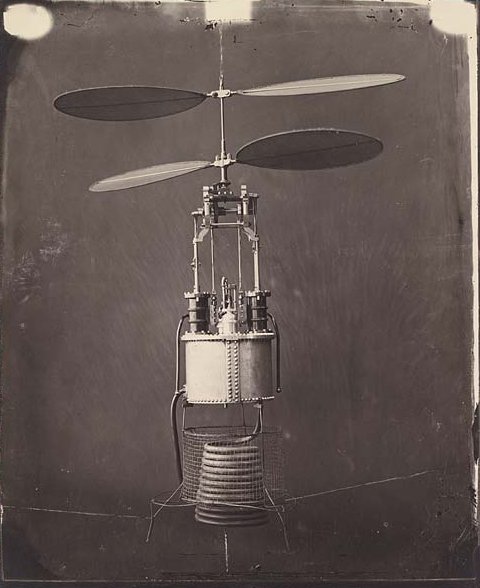
Viscount Gustave de Ponton d'Amécourt, born 16 August 1825 in Paris and died in 1888, is a French numismatist and archaeologist. He was president and founder of the French Society of Numismatics. Among his research, there are his extensive studies of Merovingian currencies delivered to the Historical and Archeological Society of Maine where he was a member.
He was a friend of Felix Nadar and Jules Verne. As a scholar, having studied mathematics, Sanskrit, Greek and Latin, he was awarded the Legion of Honor.
The word "helicopter" was coined by Gustave Ponton d'Amécourt, from the Greek Helikos (helix) and pteron (wing). This term appeared for the first time on 3 August 1861 in a patent application filed in England and later on 16 July 1862 on the certificate originally filed for patent 49,077 on 3 April 1861 in France. The inventor built with Gabriel de La Landelle a small prototype steam engine helicopter, whose boiler was one of the first uses of aluminum. Jules Verne would see a pamphlet published in 1863, which described the invention of Amécourt, and was partly inspired to describe the helicopter Robur the Conqueror.
The expensive propeller, developed by Ponton Amécourt and photographed by Nadar in 1863, would help solve the problems of air navigation.
A memorial stone was erected in the park of the town of Trilport where he served as the mayor.
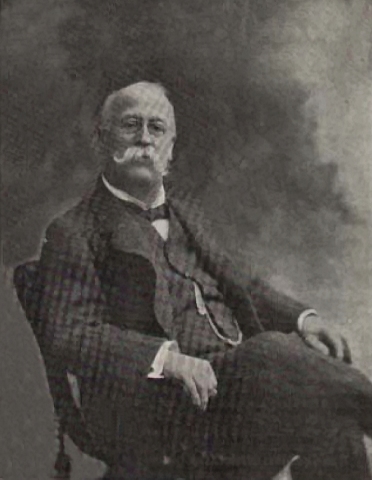
Enrico Forlanini (December 13, 1848 - October 9, 1930) was an Italian engineer, inventor and aeronautical pioneer, well known for his works on helicopters,
aircraft, hydrofoils and dirigibles. He was born in Milan. His older
brother Carlo Forlanini was a famous Italian physician (1847 – 1918).
Enrico was born to Francesco Forlanini, a notable physician and director of the Ospedale Fatebenefratelli in Milan. After elementary school he attended one of the three Milan Regie Scuole Tecniche, in 1863 he entered the military college of Turin, to pass to its military academy in 1866. Two years later he passed to the Scuola di Applicazione Artiglieria e Genio where he graduated with a diploma in 1870.
In 1877, he developed an early helicopter powered by a steam engine. It was the first of its type that rose to a height of 13 meters, where it remained for some 20 seconds, after a vertical take off from a park in Milan.
Then, he worked in Forlì, in a society named Società Anonima Forlivese per l’illuminazione a gas e per la fonderia di ferro.
Later he designed and built a series of dirigibles, notably, designed in 1901 and launched in 1909, the Leonardo da Vinci that he dedicated to the famous Renaissance inventor and, in 1912, the Città di Milano, dedicated to his beloved home town. The latter showed exceptionally good characteristics of stability and controlability that won Forlanini international renown. A further four airships were constructed: F3, F4, F5 and F6. A seventh, named Omnia Dir was only completed after his death and never flew.
He is also known for his hydrofoils that he started modeling since 1898. One of those, built at full scale, used a ladder system of foils and a 60 hp (45 kW) engine driving two counter - rotating air props. During testing on Lake Maggiore in 1906, this craft reached a top speed of 68 km/h (42.5 mph). He also tested a hydrofoil with a 25 horsepower (19 kW) steam engine but this only achieved around 50 kilometers per hour (31 mph) in 1908 - 1909.
Forlanini obtained a number of British and American patents on his ideas and designs, most of which were aimed at seaplane applications.
He died in 1930 while still working on the design of the Omnia Dir airship.
Milan has dedicated to him its city airport, also named Linate Airport, as well as the nearby park.
